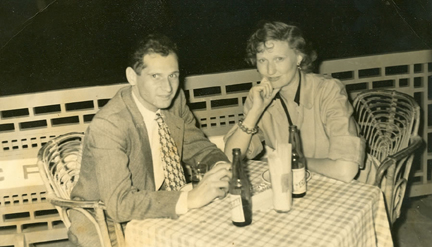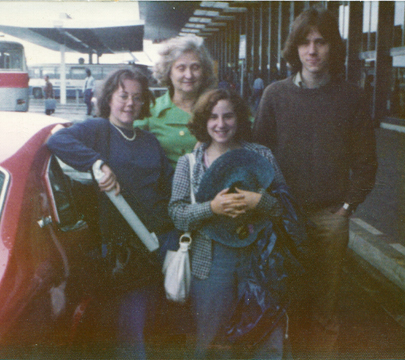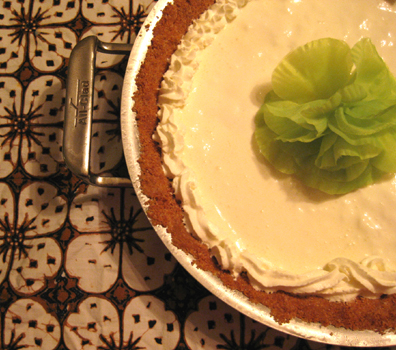
Dagny Johnson with her friend Vince Travaglini (labeled Christmas 1950, courtesy of Eric Johnson)
Key lime pie is refreshingly delicious and may just be the easiest pie in the world to make. I love it not just because of its flavor and ease, however, but because it reminds me of a magical figure in my life.
Anna Dagny Johnson and my mother were college friends. Originally from the Midwest, Dody (as we called her) contracted polio on their junior year abroad in France. Eventually the Chicago winters proved too icy for a woman on crutches, and she and her family commissioned a Japanese architect to design a perfect little one-story house on Key Largo in Florida. Hidden away from the road, encircled by native foliage, the house looked out on the Gulf of Mexico.
Although she worked for several years as a labor lawyer (a career that brought her a lifelong hatred of J. Edgar Hoover), for most of her life Dagny lived off family money and followed her heart.
She adored Paris–its rhythm, its people, its look. For decades she spent Florida’s hot summers in the City of Light, shipping her specially fitted red Ford convertible across the Atlantic Ocean so that she could be mobile in France. I remember her driving me along the boulevards when I was seven. She put the car’s top down and made me repeat the mantra “Paris is the most beautiful city in the world” until it was imprinted in my psyche.
Dagny was always a lover of film. At Mount Holyoke in the 1930s she and future Connecticut governor Ella Grasso showed documentaries about the Spanish Civil War on campus. In the 1960s she hit upon the idea of programming a festival of films shot in or about Paris. “Paris en Films” (Paris on Film) ran for several summer seasons. My brother David, Dody’s nephew Eric, and I each worked for the festival for at least one summer.
I’ll never forget my first time there. Dody had rented an ornate apartment from a Spanish nobleman. She, Eric, and I shared the apartment at night. During the day a huge cast of characters joined us. These included Madame Garcia, a Spaniard who cooked tuna omelets(!) whenever Dody wanted to entertain someone important; Agnes, who wrote letters and answered the phone; Antoine, the aristocrat who was the figurehead president of Paris en Films (Dody did most of the work); and Monsieur Lamoureux, Dody’s hairdresser, who always arrived by walking directly into her bedroom via French doors.
We also encountered figures from the film world. Alberto Cavalcanti was one of the few film directors who enjoyed strong careers in three different countries. He took part in the experimental French film movement in the 1920s, made pictures for Britain’s Ealing Studios during World War II, and returned to his native Brazil after the war to make lavish color films. By the time we met him in Paris Alberto was very old and much too fond of a drink, but he still had wonderful stories to tell and an occasional twinkle in his eye. He adored Dody. He left her his papers, which Eric donated to the British Film Institute after her death.
The festival’s films were shown outdoors that summer in the garden of the Hôtel de Sully, a historic home in Paris. Eric showed typical American organizational talent and helped transport and project the films. I was never quite sure what my role was—a little ticket taking, a little translation (since my French was pretty good at the time), a little shopping.
The festival, like Dagny herself, was always in lukewarm water financially; there were certain restaurants and hotels to which we could never return because it—or she—owed them money. Nevertheless, we somehow managed to show interesting films every night, from the experimental work of Chris Marker and Stan Brakhage to early footage by the Lumière brothers and Thomas Edison’s operatives, from “The Red Balloon” to a silent Hollywood film starring Adolph Menjou. Dody was named a chevalier des Arts et des Lettres by the French government. She was one of few Americans to receive this honor.
Eric and I were too busy running around Paris to notice what a great time we were having. Whenever we meet or write today, we exchange Humphrey Bogart’s signature line, “We’ll always have Paris.” We laugh as we say it, but it’s also true. Somehow without my realizing it our time there became one of the highlights of my youth.

Left to right: Agnes, Dagny, Tinky, and Eric in Paris
After Paris, Dagny’s other great love was the preservation of the Florida Keys. She used all her strength of character (and much of her remaining strength of body) to combat rampant development and preserve the native flora and fauna of her beloved home. She is appropriately the first figure profiled in Susan Nugent’s book Women Conserving the Florida Keys.
None of what I’ve written so far conveys the exhilarating (and sometimes maddening) experience of being with Dagny. She had passion for–and a strong opinion about–everyone and everything she encountered. Her pronouncements were never simple statements; each sentence was filled with capital letters and ended with an exclamation mark. Each vista she looked at, each mouthful she ate, was THE MOST WONDERFUL EVER!!!—something to be savored and shared with friends.
One of her great joys was the view she saw daily from her little house on Key Largo. Each afternoon she turned her sights and those of her guests to the coming sunset. She argued it was best enjoyed sipping a cocktail or nibbling on a refreshing piece of key-lime pie. We were told to linger over the sunsets; no one could stop watching until the first star came out.
Like Dody herself those sunsets over the bay were colorful and dramatic. Like her they imposed their rhythm on those who came near them: they forced us to slow down and adapt to their pace. And they were always worth the trouble it took to drop whatever we were doing and yield to their appeal.
Dagny Johnson died in 2003. She has a couple of memorials. A hammock park on Key Largo is dedicated to the memory of her efforts to save the fragile Floridian ecosystem. Appropriately, it is located at the site of one of her greatest victories in that struggle. The large arch that marks its entry was supposed to be the gateway to Port Bougainville, an oversized development she helped to avert.
Dody also has a cinematic legacy, the 1939 film Love Affair. After she contracted polio in France she and her wonderful, funny mother sailed back to the United States. On the boat they met director Leo McCarey and his wife. McCarey was so inspired by the charming, gallant crippled girl he had met on board that he created a plot that (very loosely) combined shipboard romance and loss of mobility.
The film was remade as An Affair to Remember in 1957. The films’ plots (which are identical) are creaky, but they are among the most romantic movies ever made. I think of Dody whenever I watch either version (or even the weird 1994 re-remake).
I also think of her when I make or eat any of her culinary passions—a fresh orange or avocado, a dish of crème brulé, a croque monsieur, or a cool slice of key lime pie. As the pie slides down my throat I sit once again by the Gulf of Mexico. I hear Dody rattle on about Paris and religion and the Florida Keys. And the lush yet delicate Key Largo sunset washes over me.

Key Largo Key Lime Pie
As in the key-lime chicken recipe below, do not substitute Persian lime juice for key lime juice here. And don’t worry that your key lime pie isn’t green (or add food coloring to make it so). Key limes are yellow, and your pie will be naturally tinted a very pale shade of that color.
According to the web site of Nellie & Joe’s, the company that makes the key-lime juice and recipe I use, classic key-lime pies are not baked (a plus in the Florida heat!). The lime juice is alleged to cook the egg yolks. Here in the north, however, I usually bake my pie. Some folks like to use the leftover egg whites to make a meringue topping for their pie and eschew the whipped cream. I much prefer whipped cream for texture and flavor.
Ingredients:
1/2 cup key-lime juice
1 can (14 ounces) sweetened condensed milk
3 egg yolks (use the whites in another recipe; you won’t need them here)
1 8-inch pie shell with a graham-cracker crust (preferably homemade)
whipped cream as needed
Instructions:
Preheat the oven to 350 degrees. In a medium bowl whisk together the juice, condensed milk, and egg yolks until they are smooth. Pour this mixture into your pie shell, and place the pie in the oven. Bake for 15 to 20 minutes.
The pie won’t necessarily set, but you don’t need it to!
After removing the pie from the oven let it cool to room temperature; then cover it and place it in the freezer until a few minutes before you are ready to eat. Remove the pie from the freezer, adorn it with whipped cream (either all the way across the top or just around the edges, depending on how much additional fat you want to absorb!), and serve. If you have leftover pie, store it, covered, in the refrigerator. Serves 6 to 8.
If you enjoyed this post, please consider taking out an email subscription to my blog. Just click on the link below!
Subscribe to In Our Grandmothers’ Kitchens by Email.





